Easily Increasing Property Value For Your Home With Minimal Investment

When it comes to Increasing property value, whether for your home, business, or you have a parcel of land, it’s essential to maximize your investment.
Most people assume that improving property value means major renovations, contractor quotes, and spending a lot of money out of pocket. However, a lot of value comes from simply making smarter choices, not bigger budgets.
One of the most intelligent strategies and a rule of thumb you can measure by is by using the 1% Rule of Value Addition.
The 1% Rule is simply focusing only on changes that add at least one dollar of value for every one dollar you spend. You want to make sure that you aim for the highest Return on Investment (ROI) with the lowest effort, and least amount of money invested.
You don’t need an expensive remodel that drags on for months, nor do you need to sink tens of thousands of dollars into major renovations to see viable results. You just need to make small, but targeted improvements that change how buyers feel when they walk through the door.
Reasons For Increasing Property Value
There are many reasons you may want to increase the property value such as: you’re preparing to sell, and want to get the most money for your property, building a rental portfolio, or simply just want to increase your net worth. No matter what the reason, boosting property value is always a smart move.
With the right strategy, you can significantly increase your property’s value with minimal investment. This guide breaks down the most effective, budget friendly ways to add value to your home or investment property without breaking the bank.
Why Improving Property Value Matters Even If You’re Not Selling
A lot of people assume that property value only matters when it’s time to sell. That’s not entirely true. Your property value impacts your equity, your borrowing power, and even your insurance premiums.
If you own rental properties, higher value can justify higher rents. If you’re holding them long term, building value now means more wealth later.
Think of it this way: every dollar you invest wisely into your property can return two, three, or even five times that amount in increased value. That’s strategic improvement.
The biggest mistake people make is thinking they need to do massive projects to move the needle. However, that couldn’t be farther from the truth if you do it smartly. Small, targeted upgrades can have an outsized impact if you focus on the right areas.
The goal of improving property value isn’t to transform your home or parcel of land into something it isn’t. The goal is to highlight the property’s strengths, and make buyers think, “This place has been taken care of.” That perception alone can move your property into a higher bracket without you having to overspend.
Here is your simple guide to increasing your property value without draining your bank account. We will factor in the most reliable low cost upgrades that consistently improve property value.
Focus On Curb Appeal First: Win Before They Step Inside
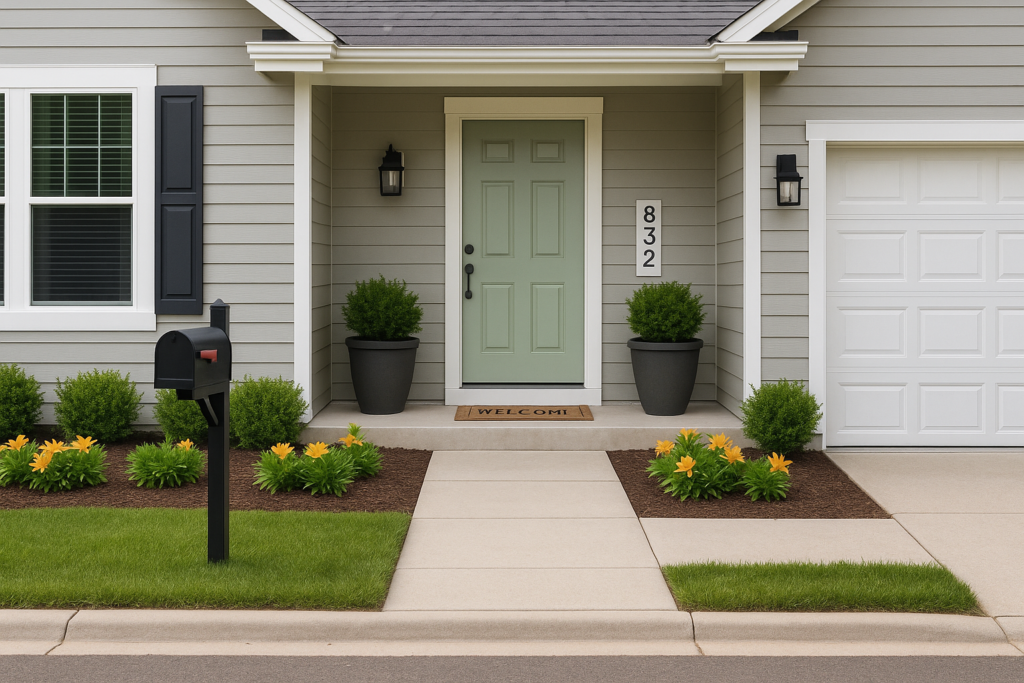
Curb appeal is the first impression your property makes. Whether it’s a potential buyer, a tenant, or an appraiser, people form opinions in seconds. If your property looks neglected from the street, everything else you do inside won’t matter as much.
Curb appeal is where you get the biggest bang for your buck. Think of it as a conspiracy to trick buyers into liking your house before they even know why. It’s all about perception.
First impressions work like gravity. They either pull buyers toward your home, or push them away before they ever step inside. You don’t need fancy landscaping or professional lighting to win the curb appeal battle.
Declutter the Yard For Better Curb Appeal:
Remove dead plants, old planters, and toys. Redo the flower beds. A crisp edge is the sign of a cared for property.
The beauty of curb appeal is that it’s one of the cheapest ways to add value. Fresh mulch, a mowed lawn, trimmed bushes, and a few strategically placed flowers can completely transform a property. You’re talking about a few hundred dollars, maybe less if you do it yourself.
Paint your front door. Replace old house numbers. Clean the gutters and pressure wash the driveway. Add a new, clean, welcome mat and a couple of planters. These are not expensive tasks, but they make a property look cared for and add curb appeal. And that perception alone can add thousands to your property’s value.
If your budget allows, also consider upgrading outdoor lighting. Good lighting makes a property look safer, more modern, and more welcoming. Solar path lights are cheap. A new porch light fixture costs are minimal, but the effect is immediate.
A well kept entrance gives buyers a sense of safety and stability. That emotional trigger often raises perceived value more than square footage or finishes, and that also helps with increasing property value.
Home Interior Renovation: Improvements To Keep Costs Low:
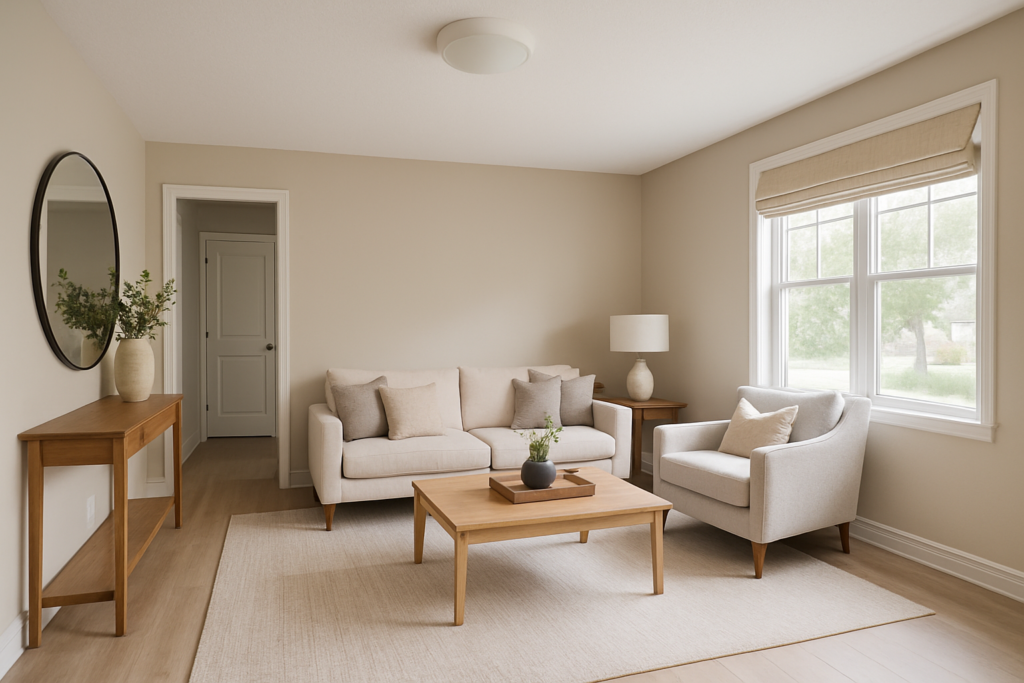
There’s a sweet spot between “don’t touch anything” and “start tearing walls down.” You want projects that make a room feel modern and functional without diving into home interior renovation territory.
If you had to pick one thing that gives you the most value for the least cost, it’s paint. Interior paint can completely change the feel of a space. Exterior paint can make an old house look new again.
Neutral colors work best if you’re selling or renting. Grays, soft whites, and warm beiges appeal to the widest audience. Avoid bold colors unless you’re keeping the property long term and it fits your personal taste.
You can paint a room yourself in a weekend. A gallon of quality paint costs are minimal and covers about 400 square feet. If you’re painting the exterior, it’s more work, but still far cheaper than most other upgrades.
Don’t overlook trim, doors, and cabinets if they need it. A fresh coat of paint can do wonders. Painting interior doors and trim gives everything a clean, finished look. These are small details that add up.
A full paint job is great, but it’s not required for value gains. You can:
- Paint only one accent wall in a strategic color.
- Paint just trim and baseboards to make the walls look newer.
- Patch dents, scratches, and nail holes.
Modern buyers are usually extremely sensitive to “maintenance signals” when it comes to your home interior renovation. When walls look clean and updated, they assume the rest of the home has been well maintained also. Even if you didn’t touch anything else. This also helps with perception and improving property value.
Improve the Space You Already Have (Don’t Add More)
You don’t need more rooms. You need more perceived space. Buyers don’t measure with a tape measure, they measure with their eyes.
Here’s where to start:
Declutter ruthlessly:
Most people think they’ve decluttered when they’ve really just rearranged their stuff. Remove half of what’s on your shelves, tables, and counters. Suddenly the room feels bigger, and higher end.
Rearrange strategically:
Move furniture away from walls. Create clean walking paths. Use fewer pieces but place them with intention. A cheap rug and a well placed floor lamp can anchor a room nicely.
Leverage mirrors:
One mirror, placed opposite a window or light source, expands a room instantly.
Place large, attractive mirrors strategically in darker rooms or narrow hallways. This reflects light and creates the illusion of more space.
You’re not redesigning, you’re redefining the entire flow of the home property without spending a lot of money.
Kitchen And Bathroom Upgrades That Don’t Cost A Fortune:
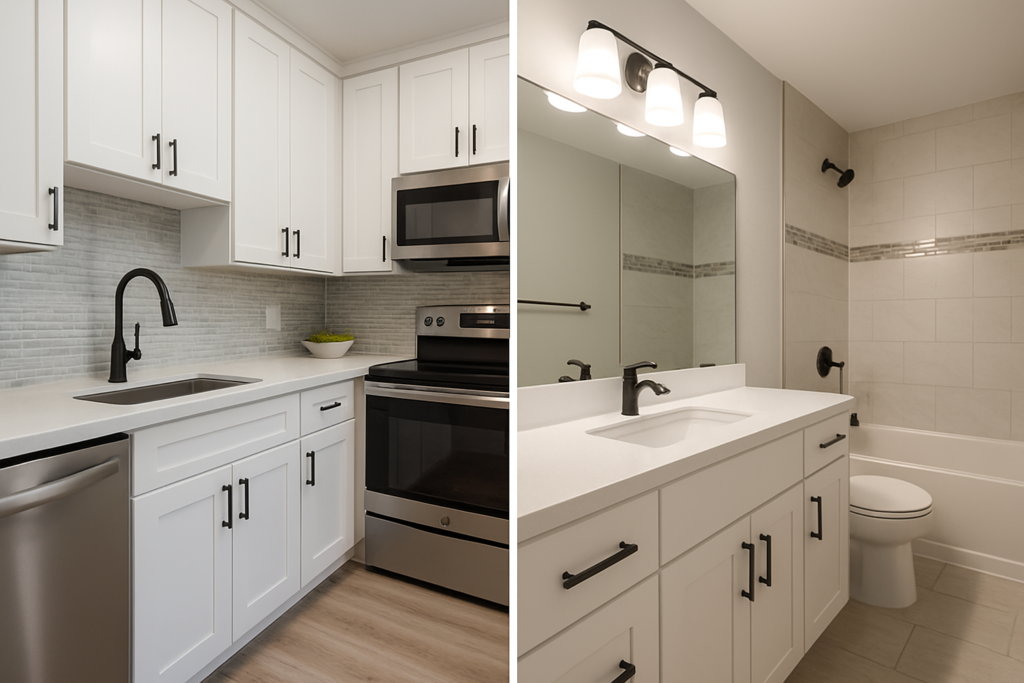
Kitchens and bathrooms sell homes, but a full home interior renovation is expensive. We’re focused on “de-aging” and making the existing fixtures look newer.
- Hardware Replacement: Replace all drawer pulls and cabinet knobs for a modern finish (matte black or brushed nickel).
- Regrout/Recaulk: Look at the caulk around your sinks, tubs, and base of the toilets. If it’s cracked, yellow, or dirty, replace it. New white caulk and a regrouted tile floor make a bathroom look instantly clean and sanitary.
- Update Faucets (Carefully): If your current faucet is a disaster, a new, simple pull down faucet for the kitchen is an easy afternoon DIY job.
- Add better showerheads. A luxurious shower experience makes the entire bathroom feel upgraded.
These upgrades cost very little, but buyers interpret them as lifestyle improvements.
In the kitchen, start with cabinet hardware. Replace the old, tarnished brass knob and deadbolt with a new, sleek set in matte black or brushed nickel. The cost is minimal, and it looks like a massive upgrade. It’s shocking how much of a difference this can make.
Next, look at your backsplash. Peel and stick tile has come a long way. You can install it yourself in a few hours for a couple hundred dollars. It looks clean, modern, and hides outdated wall finishes. This can also be useful when it comes to your home staging efforts.
If your countertops are worn but functional, consider refinishing kits. These kits let you paint or resurface countertops to look like granite or marble. They’re not perfect, but they work for budget upgrades.
Make the Bathroom Look “Hotel Clean”
Bathrooms are emotional. People react instantly to them. Create the “hotel clean” effect with:
- New shower curtain
- New bath mat
- Bright lighting
- Fresh caulk and grout
- A simple storage shelf
- Matching towels (only for home staging and showings)
These changes cost almost nothing, but they transform the space into something that looks and feels maintained, and that’s what sells.
In bathrooms, focus on fixtures. Replace the faucet, showerhead, and towel bars. Clean or replace the mirror. Add new lighting. These upgrades cost a few hundred dollars total but make the space feel updated.
If the bathtub or shower is stained or dated, reglazing is an option. It costs a few hundred dollars and can make an old tub look brand new. It’s a fraction of the cost of replacement, and will help with increasing property value.
Flooring Fixes That Add Value To Your Home Interior Renovation

Flooring is one of the first things people notice. If your floors are damaged, stained, or outdated, it drags down the entire property.
The cheapest option is to deep clean or refinish what you have. Hardwood floors can often be sanded and refinished for a few dollars per square foot. If you have carpet, a professional cleaning can make it look dramatically better.
If replacement is necessary, luxury vinyl plank is your best bet. It looks like hardwood, it’s durable, and it’s cheap. You can install it yourself if you’re handy. Even if you hire someone, it’s still far less than real hardwood or tile.
Avoid cheap laminate. It looks cheap and doesn’t hold up. Spend a little more on quality LVP and it’ll pay off in perceived value, as well as improving property value.
Home Staging: Lighting Can Change Everything
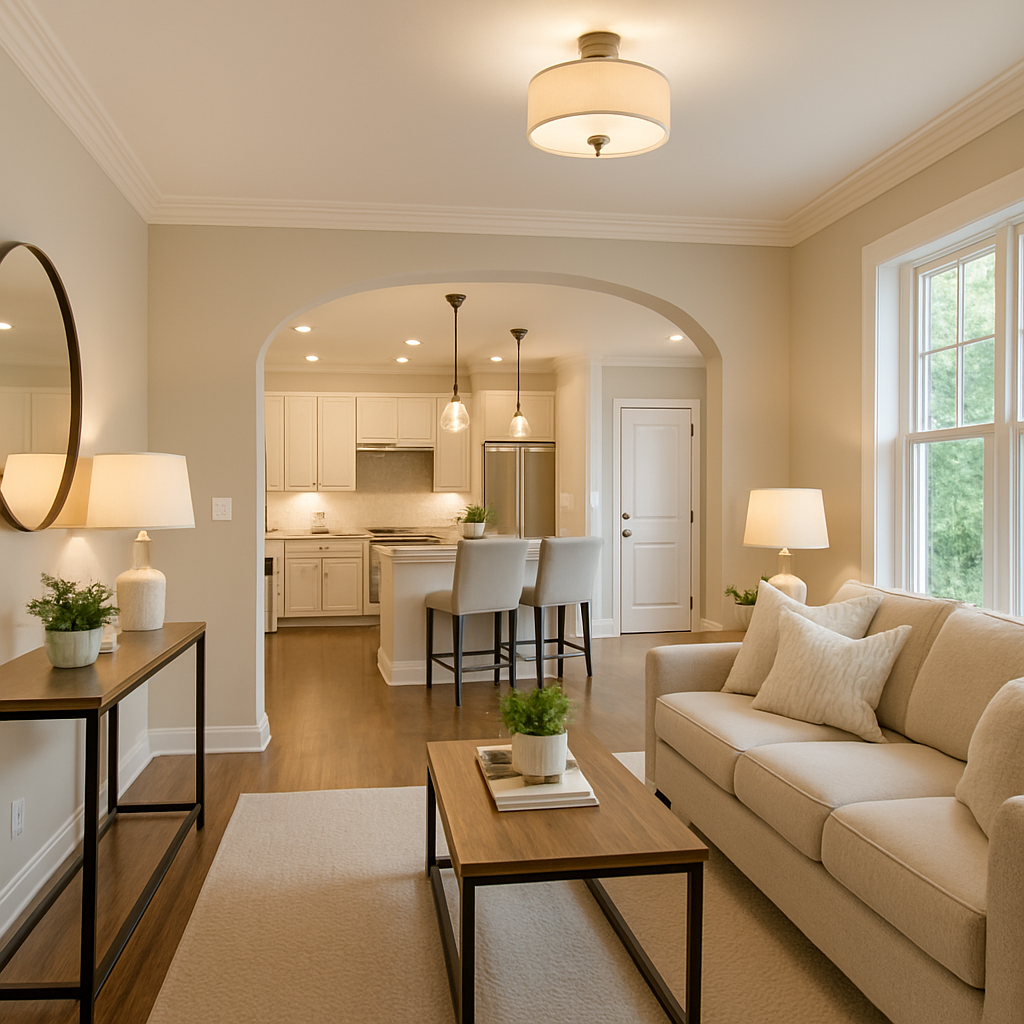
When it comes to home staging, most homes have terrible lighting. Builder grade fixtures, dim bulbs, and poorly placed lamps make spaces feel small and uninviting.
Upgrading lighting is one of the easiest and cheapest ways to improve a property. Replace old ceiling fixtures with modern ones. Add under cabinet lighting in the kitchen. replace out outdated chandeliers or pendant lights.
LED bulbs are brighter, last longer, and use less energy. Go through every room and upgrade to daylight or soft white LEDs depending on the space. It’s a small investment that makes every room look better.
One great trick is to replace all light bulbs to 4000K LED. This is the most crucial, immediate change you can make. 4000K is called “Cool White” or “Natural Daylight.” It mimics daylight and makes paint look crisp and clean, instantly eliminating the sickly yellow light of old bulbs.
Update the old fixtures: Go to a big box store and buy a few new, simple, drum style ceiling light fixtures for the main living areas.
Deep Clean Windows: Clean windows let more light in. It sounds obvious, but it’s a game changer, and practically free.
If a room feels dark, add more light sources. Floor lamps, table lamps, and wall sconces can fill in gaps. Good lighting makes spaces feel larger and more inviting, which directly impacts perceived value.
Once a buyer is inside, you’re not selling them walls and floors; you’re selling them a feeling. The goal is to make the space feel bigger, brighter, and cleaner.
Fix The Small Stuff That Buyers Notice
Buyers don’t need to find major issues to lower their offer. Small problems do the job:
- A hallway door that sticks
- A faucet that drips
- A cabinet that squeaks
- Loose doorknobs
- Yellowed caulk lines
- Wobbly toilet seats
- a cracked outlet cover
When buyers see these things, they assume the home has hidden maintenance issues. Fixing them before showings removes doubts and raises value more reliably than any trendy decor item.
Little things matter more than you think, and these things signal neglect. Even if everything else is perfect, small issues can create doubt.
Walk through your property and look at it from a buyers perspective. Make a list of every minor repair. Then knock them out in a weekend. Most of these fixes cost are minimal, but they add up to a big difference in how the property looks and feels.
Patch holes in walls. Tighten loose screws. Replace broken tiles. Fix squeaky doors. Caulk around sinks and tubs. These are not glamorous tasks, but they matter.
- Neutralize Odor: If you have pets or smoke, you need professional cleaning, not Febreze. Ozone generators can be rented for a deep, chemical free clean.
- The Scent Strategy: Bake cookies, or use a diffuser with a neutral, pleasant scent like citrus or light linen before the showing. Never use overpowering floral scents.
- Paint Touch Ups: Find every scuff, every hole, and every minor dent in the walls. A fresh coat of light, neutral paint over scuffs makes the entire house look maintained.
If you’re selling, buyers will notice. If you’re renting, tenants will appreciate it. If you’re holding, you’re protecting, and maximizing your investment.
Energy Efficiency Improvements That Pay Off
Energy efficiency is becoming a bigger factor in property value. Buyers and renters want lower utility bills. Simple upgrades can make your property more attractive without it being a major investment.
Start with weatherstripping around doors and windows. It’s cheap and easy to install. Seal air leaks with caulk. Add insulation to the attic if it’s insufficient.
Replace old thermostats with programmable or smart thermostats. They don’t cost a lot, and help control heating and cooling costs.
If your appliances are older, consider upgrading to Energy Star models. They don’t have to be high end. Mid range Energy Star appliances are affordable, and they also add value.
Even small changes like switching to LED bulbs and installing low flow faucets and showerheads signal that the property is modern and efficient.
Don’t Overlook Storage And Organization For Home Staging:
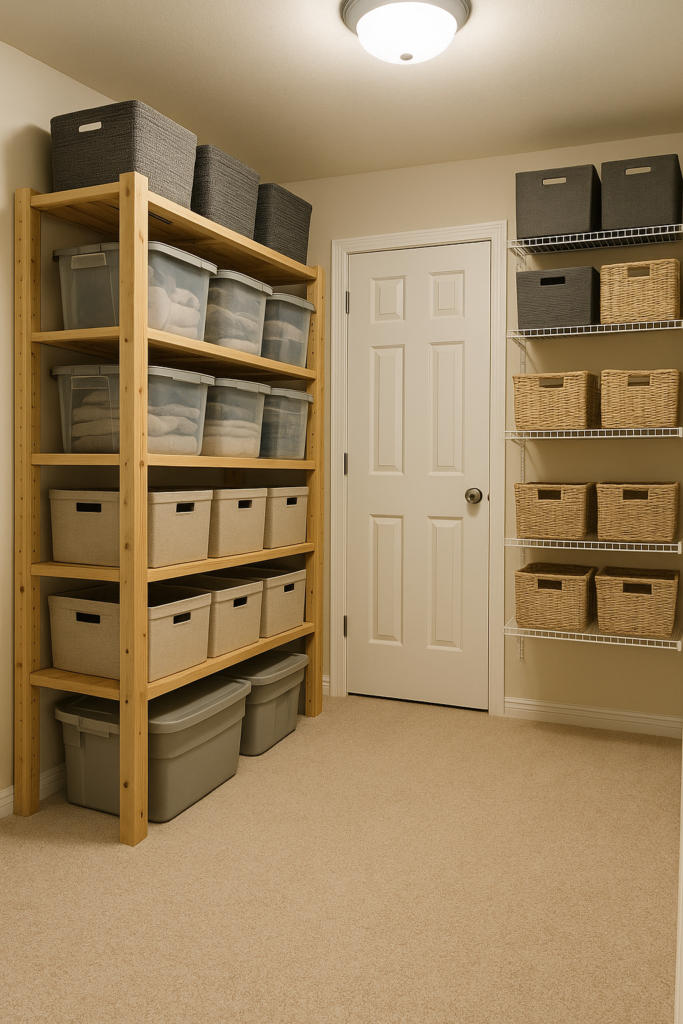
Storage is always a selling point. If your property feels cluttered or lacks storage, it can hurt the value.
Add closet organizers. They’re inexpensive and make closets feel bigger and more functional. Install shelving in the garage or basement. Add hooks, racks, and storage bins where needed.
If you have an unfinished basement or attic, simple organization can make these spaces feel more usable. You don’t need to finish them completely, just make them functional.
Decluttering is free, and has a huge impact. Remove excess furniture, clear countertops, and clean out closets. Spaces feel larger and more valuable when they’re not packed with stuff.
Document Improvements for Added Perceived Value
Most homeowners never do this, but it’s one of the easiest ways to raise buyer confidence:
Document every improvement you make.
A simple list with dates is enough.
Buyers see it and instantly think that you spent a lot of money on your home interior renovation.
Their perceived value of the property skyrockets.
Final Thoughts On Increasing Property Value For Your Home With Minimal Investment:
Increasing, and improving property value doesn’t require massive budgets or months of construction. It requires smart choices, attention to detail, and a focus on the things that matter most to buyers, tenants, and appraisers.
Start with the basics: curb appeal, paint, and small repairs. Then move into targeted upgrades in kitchens, bathrooms, and lighting. Focus on making your property feel clean, modern, and well maintained.
Every improvement you make should pass a simple test to add more value than it cost.
With the right approach, you can significantly boost your property value with minimal investment and set yourself up for better returns whether you’re selling, renting, or holding long term.
The most powerful improvements are the ones buyers emotionally respond to:
- Clean, modern lighting
- Updated hardware
- Fresh entryway
- Clean walls and trim
- Organized rooms
- Functional, updated small fixtures
When a home “feels” modern and well maintained, buyers mentally place it above competing properties, even if yours has no major renovations.
You don’t need a giant budget for curb appeal, or a home interior renovation crew for increasing property value. You just need the right touch in the right places. A small number of intentional upgrades can make your home feel more modern, more spacious, and more cared for.
If you apply even half of these strategies, you can raise your property’s perceived value dramatically without overspending.
If you enjoyed this article be sure to also check out our 8 Tips for first time home buyers.
